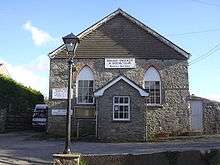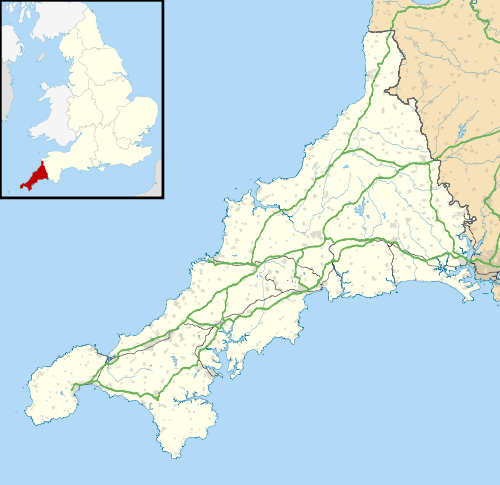Breage, Cornwall
Coordinates: 50°06′29″N 5°19′55″W / 50.108°N 5.332°W


Breage (/ˈbriːɡ/ BREEG, local /ˈbreɪɡ/ BRAYG;[1] Cornish: Eglosbrek[2]) is a civil parish and village in Cornwall, England, United Kingdom. The village is three miles (5 km) west of Helston.[3]
Other settlements in the parish include the villages of Ashton, Carleen and Godolphin Cross; the coastal village of Praa Sands; and the Great Work mine. The ward population at the Census 2011 had increased to 4,757.[4] Breage civil parish had a population increase to 3181.[5]
Breage is named after Saint Breaca, a missionary from Ireland (to whom the 15th-century church is dedicated) and it is in the former Kerrier District.
History
The parish was at the time of Domesday Book within the manor of Binnerton. There were 8 hides of land with enough for 60 ploughs. There were 32 villagers and 25 smallholders with 15 ploughs between them. Apart from the arable land there was 2 acres (0.81 ha) of meadow, 2 sq leagues of pasture and half a sq league of woodland. Livestock were 45 mares, 13 cattle, 5 pigs and 60 sheep; the annual value was £10.[6]
Geography
The geological formation known as the Tregonning-Godolphin Granite (one of five granite batholiths in Cornwall) underlies the parish[7] and the area was formerly an important source of tin and copper ore (see Geology of Cornwall). The area has evidence of habitation and mining for the past two millennia. Other than Praa Sands, the villages in the parish were tin and copper mining villages. Breage itself was where the mine owners (or captains) lived as evidenced by the number of fine buildings in the village. The village water pump (presumably now disconnected) still stands today as a relic of the past. Most of today's working population are commuters, travelling to Helston, RNAS Culdrose, Porthleven, Penzance, Falmouth or even further afield. Some residents are still involved in farming or smallholding in the surrounding area. Ashton is at grid reference SW 604 286: it is situated on the A394 Penzance-Helston road one mile (1.6 km) north of Praa Sands. Ashton has a pub called the Lion and Lamb and at one time had a football team.
The following hamlets are in the parish: Ashton; Broadlane; Carleen; Godolphin Cross; Gwedna; Hendra; Kenneggy; Millpool; Pengersick; Penhale Jakes; Polladras; Praa Sands; Rinsey; Rinsey Croft; Trenwheal; Trescowe; Tresoweshill; Trevena; and Trew.[8]
Protected areas
Tregonning Hill, to the west of the parish, was designated a Site of Special Scientific Interest (SSSI) in 1994 for its biological interest.[7] Tremearne Par SSSI and Porthcew SSSI, along the coast west of Porthleven, were designated for their geological interest and are also Geological Conservation Review (GCR) sites.[9][10] Great Wheal Fortune was a small mine in operation between 1855 and 1880 and produced 2992 tons of tin, 322 tons of copper and some arsenic and tungsten. In 1991 it was designated a SSSI and is also a GCR site of national importance.[11][12]
Parish Church
The church was built of granite in the 15th century: on the north wall are five medieval wall paintings. A Roman milestone of the 3rd century is preserved in the church and in the churchyard there is an unusual Hiberno-Saxon cross head.[13] The inscription on the milestone is: IMP [C] DO NO MARC CASSI: this incomplete text refers to the Emperor (Marcus Cassianus) Postumus, 258–68 AD (Collingwood, RIB no. 2232).[14]
Notable people
- Sidney Godolphin, the Cavalier poet and courtier, was baptised in Breage.
- Major-General David Tyacke, the last Commanding Officer of the Duke of Cornwall's Light Infantry was born and buried in Breage, where his family had been involved in tin-mining since the early 18th century.[15][16]
References
- ↑ Miller, G. M., ed. (1971) BBC Pronouncing Dictionary of British Names. London: Oxford University Press ISBN 0-19-431125-2; p. 20
- ↑ Place-names in the Standard Written Form (SWF) : List of place-names agreed by the MAGA Signage Panel Archived 15 May 2013 at the Wayback Machine.. Cornish Language Partnership.
- ↑ Ordnance Survey: Landranger map sheet 203 Land's End ISBN 978-0-319-23148-7
- ↑ "Breage electoral ward population 2011". Retrieved 5 February 2015.
- ↑ "Breage Civil Parish population 2011". Retrieved 5 February 2015.
- ↑ Thorn, C. et al. (eds.) (1979) Cornwall. Chichester: Phillimore; entry 1.16
- 1 2 "Tregonning Hill" (PDF). Natural England. 1994. Retrieved 28 October 2011.
- ↑ Cornwall; Explore Britain
- ↑ "Tremearne Par" (PDF). Natural England. Retrieved 3 November 2011.
- ↑ "Porthcew" (PDF). Natural England. 1990. Retrieved 9 November 2011.
- ↑ "Wheal Fortune". Retrieved 6 December 2011.
- ↑ "Great Wheal Fortune" (PDF). Natural England. Retrieved 6 December 2011.
- ↑ Pevsner, N. Buildings of England: Cornwall (1951; 1970) (rev. Enid Radcliffe) Penguin Books (reissued by Yale U. P.) ISBN 0-300-09589-9; p. 46
- ↑ Collingwood, R. G.; Wright, R. P. (1965). The Roman Inscriptions of Britain. I: Inscriptions on stone. Oxford: Clarendon Press.
- ↑ "Major-General David Tyacke". The Times. 9 March 2010. Retrieved 11 May 2010.
- ↑ "Packed funeral". Cornish Guardian, The West Briton, Western Morning News, The Cornishman. 22 April 2010. Retrieved 11 May 2010.
External links
| Wikimedia Commons has media related to Breage, Cornwall. |
